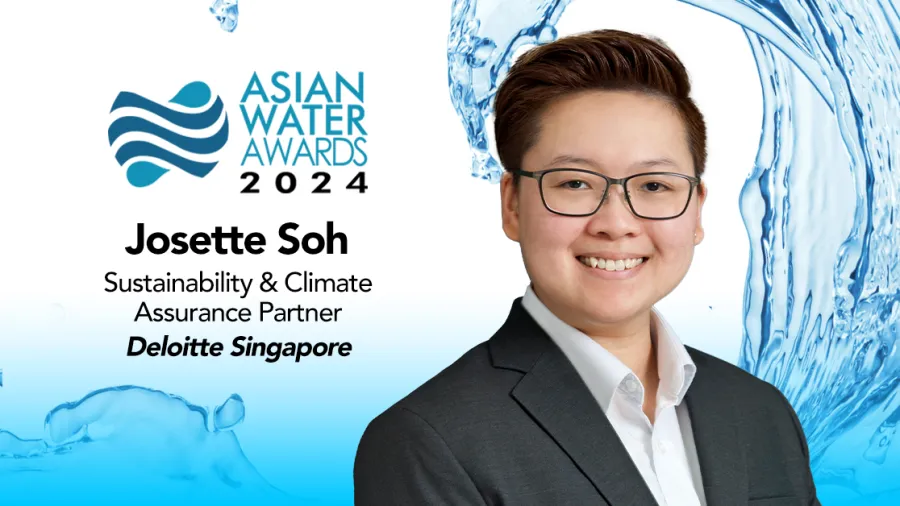
Human behaviour to have ‘long-lasting’ impact on water conservation goals, says Deloitte Partner
Water continues to be an important resource amidst greater sustainability considerations.
Similar to many industries, there is a growing need for the water industry in Asia Pacific to develop a more sustainable operation amidst water scarcity and quality issues. In this dynamic landscape, industry leaders such as Josette Soh are at the forefront of advancing this progress.
Soh is Sustainability & Climate Assurance Partner at Deloitte Singapore, leading the company’s ESG Assurance practice with more than 17 years of professional service experience under her belt. Currently based in Singapore, she is a trusted advisor for sustainability-related advisory, focusing on the interconnectedness of sustainability and finance.
She has led many sustainability and accounting training sessions for listed companies and multinationals, where she enriches participant experiences through industry scenarios and discussions on allowable practices.
Soh sits down with the Asian Water Awards as part of its distinguished panel of judges to talk about pressing sustainability challenges in Asia’s water sector, integrating sustainability practices into companies’ financial strategies, advancements in ESG reporting and the assurance practice, as well as improving transparency and accountability in climate reporting.
From your perspective, what are the most pressing sustainability challenges faced by the water sector in Asia today?
The water sector in Asia faces the triple threat of social, economic, and climate crises. Key challenges include water scarcity, pollution, aging infrastructure, and climate change. These pose significant risks to the region's environment, public health, and economic development.
Water scarcity is a major issue which is driven by population growth, urbanisation, and industrialisation in many Asian countries.
Water pollution is another serious problem, with many water sources contaminated by untreated wastewater, agricultural runoff, and hazardous chemicals, thus affecting water quality and availability for consumption, irrigation, and ecosystems. Additionally, polluted water poses a threat to human health and biodiversity.
Aging infrastructure compounds these issues, leading to a high amount of water loss, energy consumption, and operational costs.
Climate change exacerbates existing water problems and creates new ones. It affects the hydrological cycle, altering the patterns and variability of precipitation, temperature, and evaporation. This results in more frequent and severe droughts, floods, storms, and sea-level rise, affecting water resource availability and quality.
Addressing these challenges requires an integrated approach which combines policy reform, technological innovation, and collaborative efforts across sectors.
How can companies in the water sector better integrate sustainability practices into their financial strategies to achieve long-term success?
Sustainability practices are now imperative for companies with a large water footprint. Besides utilities involved in water purification, supply, and remediation, companies with significant water use must demonstrate to regulators, customers, investors, and stakeholders how they integrate sustainability into their financial strategies and operations.
Most listed companies in Singapore, particularly those in the information and communications technology (ICT) sector and financial services industry, have implemented recommendations from the Task Force on Climate-related Financial Disclosures (TCFD). In the ICT sector, data centres are significant consumers of water, and banks, insurers and asset managers in the financial services industry must account for water impact in their risk management, financing, and investing decisions. This framework helps them disclose climate-related risks and opportunities, therefore enhancing risk management, strategic planning, and communication of climate performance to investors and regulators.
Some companies have adopted the International Water Stewardship Standard (IAWS), which provides criteria for measuring and improving water stewardship. This helps optimise water use, reduce water-related risks, and contribute to sustainable water management in their catchments.
Companies should also prepare to adopt the latest sustainability standards and initiatives, such as those from the International Sustainability Standards Board (ISSB), the Task Force on Nature-related Financial Disclosures (TNFD), and the Corporate Sustainability Reporting Directive (CSRD). This ensures consistent, comparable, and comprehensive sustainability reporting and reflects global best practices.
To achieve long-term success, companies in the water sector must integrate sustainability into their financial strategies. This includes embedding sustainability goals into core business and financial planning processes and leveraging green financing mechanisms, such as green bonds and sustainability-linked loans.
By aligning financial strategies with sustainability objectives, companies can create enduring value and resilience.
What advancements have you seen in ESG reporting and assurance practices in Southeast Asia since you started, and where do you think there is still room for improvement?
ESG reporting and assurance practices in Southeast Asia have significantly improved over the past decade as more companies recognise the benefits of disclosing their sustainability performance.
Key advancements include:
- The increased number and quality of sustainability reports, with more companies following international standards such as the Global Reporting Initiative (GRI), the International Integrated Reporting Council (IIRC), and the Sustainability Accounting Standards Board (SASB).
- The development of the ASEAN Green, Social, and Sustainability Bond Standards, which provide a voluntary platform for issuers and investors to access the green, social, and sustainability bond markets in the region, based on the International Capital Market Association (ICMA) principles and guidelines.
- The adoption of the Singapore-ASEAN framework for transition finance, which provides guidance and best practices for companies in carbon-intensive sectors to transition to low-carbon and sustainable business models, aligned with the Paris Agreement and the UN Sustainable Development Goals. This framework can help companies identify and disclose their transition strategies, pathways, and targets, and to access financing and support from investors and regulators.
- The introduction of the International Sustainability Standards Board (ISSB), which promotes consistency and transparency in sustainability reporting.
However, there is still room for improvement in ESG reporting and assurance practices in Southeast Asia, such as:
- The need for more consistent and comparable data and metrics, as many companies still use different definitions, methodologies, and boundaries for measuring and reporting their ESG performance and impacts.
- The need for more independent and credible assurance, with many companies relying on self-assessment or internal verification rather than external assurance by qualified and independent third parties.
- The need for more stakeholder engagement and materiality assessment, as many companies still do not adequately identify and prioritise the issues that are most relevant and significant to their business and stakeholders.
- The need for more integration and alignment, as many companies still report their ESG performance and impacts separately from their financial performance and strategy, rather than integrating them into a coherent and comprehensive narrative that can be meaningfully interpreted by investors and external stakeholders.
- Further advancement in transparency and utilisation of digital tools for ESG data collection and analysis remains crucial.
Climate reporting is becoming increasingly critical. What specific aspects of climate reporting should water companies focus on to improve transparency and accountability?
Climate reporting is becoming increasingly critical for water companies, as they face both physical and transition risks related to climate change. Physical risks refer to the direct impacts of climate change on water resources and infrastructure, such as changes in water availability and quality, increased frequency and intensity of extreme weather events, and damage to assets and operations. Transition risks refer to the indirect impacts of climate change on water markets and regulations, such as changes in water demand and pricing, increased pressure from stakeholders and policymakers, and shifts in consumer preferences and behaviour.
Water companies can enhance transparency and accountability in climate reporting by focusing on:
Climate governance: Disclose how climate-related risks and opportunities are managed and integrated into strategic planning and decision making, which includes board and senior management roles and responsibilities, policies, procedures, and the tools and systems for climate risk assessment and management.
Climate strategy: Disclose how climate-related risks and opportunities are identified and aligned with the Paris Agreement and Sustainable Development Goals (SDG), including scenarios, assumptions, time horizons, metrics, targets, and actions for mitigation and adaptation.
Climate risk management: Water companies should disclose how they implement and monitor their climate strategy, and how they evaluate and address their climate-related risks and opportunities. This includes the risk identification and assessment, the risk mitigation and adaptation, and the risk reporting and disclosure in line with TCFD recommendations.
Climate metrics and targets: Disclose how performance and impacts are measured and tracked, and how they compare and benchmark them against peers and industry standards. This includes greenhouse gas emissions, water use and efficiency, climate resilience and adaptation, and climate-related financial impacts and implications.
Clear and consistent reporting on these aspects will provide stakeholders with a comprehensive understanding of the company’s climate strategy and performance.
What emerging trends in sustainability and finance do you believe will have the most significant impact on the water sector in the coming years?
The biggest change maker is human behaviour. As sustainability considerations are increasingly becoming central to financing and investment decisions, water is recognised as an important resource that we all must work to conserve. Therefore, the behavioural change of consumers, investors, and conservers in ASEAN, one of the most water scarce parts of the world, will have immediate and long-lasting implications.
Emerging trends in sustainability and finance that may significantly impact the water sector in the coming years include:
Circular economy principles: Minimising waste and optimising resource use can drive innovations in water reuse and recycling.
Sustainable and impact investing: This trend will increase capital for water projects aligned with the UN SDGs, particularly SDG 6 on clean water and sanitation. Water companies will need to demonstrate and communicate their impact performance to attract and engage with impact investors and intermediaries.
Digital transformation: Leveraging data and analytics, artificial intelligence, blockchain, and the Internet of Things can enhance water management and operations if managed correctly. This transformation requires new forms of collaboration and innovation. Water companies will need to embrace and harness digital technologies and platforms, and address the issues of data quality, security and privacy.
Nature-based Solutions: Leveraging natural processes to address water challenges is gaining traction and promises sustainable outcomes.
Reflecting on your experience as a returning judge for the Asian Water Awards, what are some standout qualities of winning projects?
Winning projects typically stand out due to their innovation, scalability, and impact. These projects often leverage cutting-edge technologies or novel approaches to address water-related challenges. Scalability is key, as projects that can be replicated or expanded to benefit larger populations have a more significant impact. Additionally, winning projects demonstrate a clear and measurable positive impact on sustainability. Successful projects also engage effectively with local communities and stakeholders.



















 Advertise
Advertise






